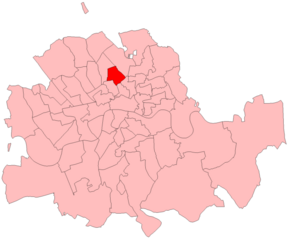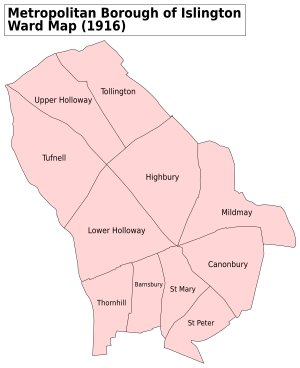Islington South (UK Parliament constituency) facts for kids
Quick facts for kids {{{Name}}}[[{{{Type}}} constituency]] |
|
|---|---|
| [[Image:{{{Map1}}}Constituency.svg|120px|]] [[Image:England{{{Map2}}}.svg|120px|]] |
|
| {{{Name}}} shown within [[{{{Entity}}}]], and {{{Entity}}} shown within England | |
| Created: | {{{Year}}} |
| MP: | {{{MP}}} |
| Party: | {{{Party}}} |
| Type: | House of Commons |
| County: | [[{{{County}}}]] |
| EP constituency: | [[{{{EP}}} (European Parliament constituency)|{{{EP}}}]] |
Islington South was a special area in North London that had its own representative in the UK Parliament. This representative was called a Member of Parliament (MP). An MP is someone chosen by voters to speak for them in the House of Commons.
This area, or "constituency," was created for the election in 1885. It stopped being a separate constituency for the election in 1950.
Contents
What were the boundaries of Islington South?
From 1885 to 1918
At first, the Islington South area was made up of three smaller parts called "wards." These wards were Barnsbury, St Mary, and St Peter. These names came from older local government areas in Islington.
From 1918 to 1950
Later, in 1918, the way these areas were defined changed. This was due to a new law called the Representation of the People Act 1918. Even with the changes, Islington South still included the same three wards: Barnsbury, St Mary, and St Peter. These wards were part of the Metropolitan Borough of Islington.
Who were the Members of Parliament?
Here are the people who represented Islington South in Parliament:
| Election | Member | Party | |
|---|---|---|---|
| 1885 | Henry Spicer | Liberal | |
| 1886 | Sir Albert Rollit | Conservative | |
| 1906 | Thomas Wiles | Liberal | |
| 1918 | Charles Higham | Unionist | |
| 1922 | Charles Garland | Unionist | |
| 1923 | William Cluse | Labour | |
| 1931 | Tom Howard | Conservative | |
| 1935 | William Cluse | Labour | |
| 1950 | constituency abolished | ||
Elections and Voting
People in Islington South voted in general elections to choose their MP. These elections happened every few years. The person who got the most votes became the MP for the area. Sometimes, the MP would change from one political party to another.
For example, in 1885, Henry Spicer from the Liberal Party won. But in the very next election in 1886, Sir Albert Rollit from the Conservative Party won instead. This shows how voters could change their minds.
Later, in 1923, William Cluse from the Labour Party won the seat. He held it for several years, even winning again in 1935 and 1945. This shows that some MPs were very popular in their area.
Images for kids
See also
- Islington constituencies






